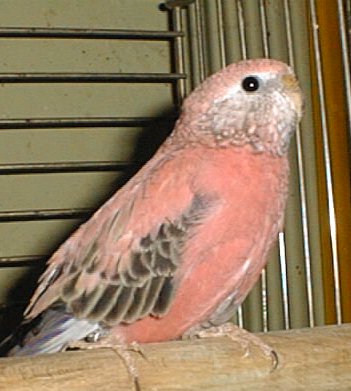Parakeet - Bourke's
Bourke's Parrot Scientific Name: Neophema bourkii
Wed, 8th January, 2025 - 6:40 am GMT
Sponsor Ads:

Alternative Name
Bourke's Parrot Scientific Name: Neophema bourkiiBasic Info
The Bourke's Parakeet is quite distinct in that its primary plumage is not green. Instead they range from grey to a beautiful sunset pink. It is the only member of its genus (Neophema) that lacks green primary plumage. They are relatively small, measuring approximately 7.5 inches (19 centimeters) in length, though females tend to be smaller than males. The average adult will weigh between 42 and 49 grams. In addition to the size differences, males may also be distinguished from females, because the males have blue feathers above the nares. This may be present in females, but it is generally much duller. They are mainly grey, pink, and blue, and females are duller than males and they have a white wing stripe. Immature individuals will have duller coloration than the adults and they lack the blue frontal band. Adult plumage is usually reached by 8 or 9 months of age. In addition to the wild type, also called "normal," there are several color variations. Some of the most popular are the Rosy (also called Rosa), Yellow (also called the Cream) and the Pink Bourke. Bourke's have large eyes, and this may be an adaptation to the fact that they are most active when the sun is not as high.
Health
Bourke's Parakeets should have a fairly large cage, lengthwise, to allow space for flying. A cage 24x24x30 inches high should be sufficient, though a larger cage would always be appreciated. If you should decide to get a larger cage, length is more important than height. The cage must have a bar spacing of no more than half an inch. Bourke's need to be fed a varied diet that may should consist of pellets, a high-quality seed mix, and fresh dark leafy greens, corn, carrots, and other green, orange, and yellow veggies, and grains such as quinoa and brown rice. Fruit is a nice treat but is not necessary. Breeding In the wild the Bourke's Parakeet breeds from August until December. The average clutch size ranges from 4 to 6 eggs. The incubation period lasts 18 days, and unlike some parrot species the male does not participate in brooding. The babies will fledge in approximately 4 weeks but will often stay with the parents for an extended period of time. The first Bourke's Parakeets were bred in Belgium in 1877. Since this time they have been bred with much success. The Bourke's Parrot is also reported to be a good foster parent for other Grass Parakeets and Mulga ParakeetsHabitat
They generally prefer open habitats of arid or semi-arid scrublands, and are seen in pairs or small group usually no larger than 10 to 30 individuals.Behavior
The Bourke's Parakeet, also know as the Bourke's Parrot, is a quiet little bird, whose pleasant chirping is a delight for many. Bourke's Parakeets are relatively hardy birds and are an excellent choice for beginning breeders. The Bourke's Parakeet has a gentle disposition and does well in aviaries with other bird species such as cockatiels and finches. These parakeets are usually most active at dawn and dusk and their sweet voices are usually heard then. If they are kept in an aviary, these are the times they usually fly. During other parts of the day they remain relatively sedentary. When compared to some other parrot breeds, the Bourke's is relatively non-destructive and can be housed in a planted aviary. If you decide to keep one as an indoor pet, a handfed individual is recommended. As pets they are reported to be affectionate and relatively quiet, making them quite suitable to apartment living. Their calls are typically only heard when they fly in the wild, and are often described as a melodic soft tinkling. They may also give a sharp high-pitched alarm call if they are startled, and some may twitter cutely when they eat. The Bourke's Parakeet is not as active as many birds, and to some this may be a drawback, but if you are looking for a fairly inactive parrot with a sweet and gentle disposition this may be the perfect bird for you. The average lifespan of this parakeet is 8 to15 years.Origin
AustraliaHistory
The Bourke's Parakeet is native to Australia and is seen throughout the central and southern interior regions. There have also been reports of sightings in the western regions as well. Though their populations are increasing due to conservation efforts, these birds are still protected in Australia. The Bourke's Parakeet has a long history and was first bred in captivity in 1877. Their name is derived from that of Sir Richard Bourke, who was the governor of New South Wales from 1831 to 1837.Common Foods
N/ASponsor Ads:
In third-world politics, the people with the guns call the shots. -- Unknown
Parakeet - Bourke's
Coded by: BGID® | ALL RIGHTS RESERVED Copyright © 2000-2025
Disclaimer | Privacy | Report Errors / Contact | Credits


 Preparing For China. China is growing their military. China Military Technology - can it keep up with the US?
Preparing For China. China is growing their military. China Military Technology - can it keep up with the US?  versus
versus 

 versus
versus 
 This Thread is about the North Korean Military itself - the kind of army, navy, and air force they have.
This Thread is about the North Korean Military itself - the kind of army, navy, and air force they have. 
 versus
versus 
 versus
versus  versus
versus